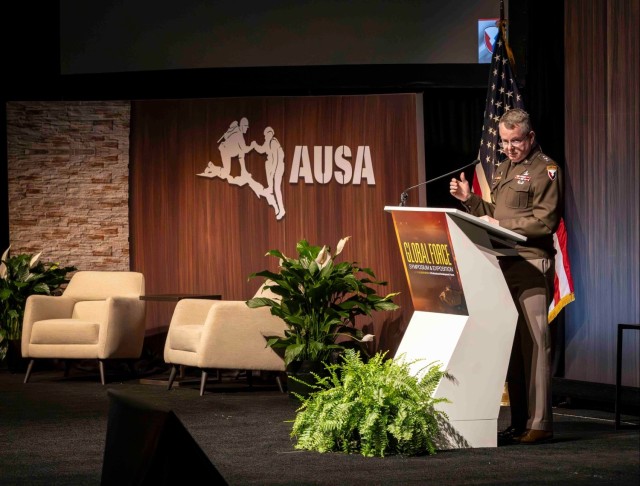HUNTSVILLE, Ala. — Drawing a vignette set five years in the future, Lt. Gen. Chris Mohan, deputy commanding general and acting commander of Army Materiel Command, painted a picture of future battlefield sustainment and highlighted the Army's progress in achieving that vision.
Addressing attendees at the Association of the United States Army Global Force Symposium on March 26, 2025, Mohan described a forward-deployed High Mobility Artillery Rocket System unit experiencing a critical system failure quickly re-establishing combat capability through tele-maintenance, advanced manufacturing and drone delivery. This scenario, he emphasized, is within reach thanks to ongoing advancements in technology and sustainment strategies.
"This is a future state but let me assure you that we are closer now than ever before," Mohan said, adding that to make it a reality, the Army needs industry’s help. “We have to be agile, and this is where we really, really need your help, help us with our agility, challenge us.”
Mohan called on industry to assist with tech data. He said that AMC has more than $240 million of delinquent backorders, for parts that industry can no longer produce but the Army can — with the right information.
“Work with us and let us try to manufacture them ourselves, either at the tactical level if they're a simple polymer printed part or all the way up to 3D printing titanium,” Mohan said.
He underscored the impact tech data access would have on Army readiness with the expanding role of 3D printing, saying the Joint Manufacturing and Technology Center at Rock Island Arsenal is actively producing parts for field requirements and currently has 49 authorized Battle Damage Repair and Fabrication lines in the data repository and has already printed over 224 parts for field requirements. These advancements, along with tele-maintenance, artificial intelligence and delivery through unmanned aerial systems and unmanned watercraft, will change future sustainment on the battlefield, said Mohan.
Mohan also touted the success of the Operational Readiness Program, a partnership with U.S. Army Forces Command to enhance the readiness of units, particularly those with legacy equipment, by sending Organic Industrial Base artisans to work with them during pre-deployment and deployment phases, while also building data analytics to predict future readiness needs.
“The goal of ORP is to increase unit readiness by 10%, and we are seeing much greater gains,” Mohan said.
The success of the program was further highlighted that day during a Warriors Corner panel, “Leading the Charge — Operational Readiness Program.” Brig. Gen. Terry Tillis, 1st Cavalry Division deputy commanding general - support, said the OIB fly away teams were able to help the unit achieve a 9-11% increase in combat power during a recent rotation at the National Training Center.
“It’s the teamwork. We take some of these subject matter experts who have been working on these systems for 15 years and they join our young Soldiers, who have been in the Army for 14 months and they are learning side-by-side,” said Tillis. “Think about the confidence it gives them to know that they can perform the function but also they can do it in the field, at NTC where conditions are difficult.”
Tillis said that generation of combat power allowed them to maximize their training opportunities, and they left NTC as the most lethal brigade combat team both in force-on-force and in live fire.
“We have a vision for the future that is not far-fetched, we have it at our fingertips,” said Mohan. “We just have to have the intestinal fortitude and courage to do the right things to pick winners and losers, and to accelerate successful initiatives, while moving on to the next target.”




Social Sharing